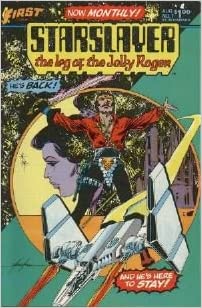 “He’s back! And he’s here to stay!”
“He’s back! And he’s here to stay!”
So says the cover of issue #7 of Starslayer, the first one published by First Comics in 1983 following the conclusion of the Pacific Comics series two years earlier. In fact, the inside cover of issue #7 has a text piece by Mike Gold that tells the entire story of how Starslayer came to be published at Pacific and then First–mainly, it was scheduled for publication at DC but then was canceled before it could be printed due to the DC Implosion (I believe the timeline matches up here) and then, after Grell got the rights to the character in his hands, he took it to Pacific for those six issues in ’81-’82. The book was actually supposed to turn into an ongoing but Grell and Gold had such a good relationship and First was already going to be publishing Jon Sable, Freelance that it made sense for them to also publish Starslayer. The only condition was that Grell wasn’t going to draw the book because he didn’t have the time to do story and art on more than one book. That’s how we have him writing but finished art by Lenin Desol and Mike Gustovich, who are outstanding replacements for the series’ creator.
The book, at this point, has the unenviable task of answering the question, “Okay, now what?” After all, the miniseries ended with the amulet being assembled and Earth being sacrificed to save the billions of other beings who were spread throughout the rest of the solar system. Well, what Grell does is that he takes our heroes and puts them in a Battlestar Galactica/Lost in Space scenario. They are flying throughout the cosmos in search of a planet that will be another Earth. It’s a great idea considering that he doesn’t have the constraints of a TV budget and therefore can go as big as he wants to. Plus, we still have the Death Star Conference Room Earth Council as villains who are operating int he background with a new massive ship, kind of like how Vader had the Super Star Destroyer in The Empire Strikes Back.
Again, these riffs on the pop culture of the day are an asset, as they hook the audience in and Grell decides to take the familiar tropes of Star Wars and pirates and head in whatever direction he wants. He also does his readers a surface and recaps the first series over the course of issue #7, since we really can’t count on First’s readers knowing the Pacific Comics series and the back issue market in 1983 not being what it would have been if this were 1993 or even now. So this is how I learned that Thorin is a Celtic warrior who was whisked away to the future. We also learn that he had a wife named Gwynyth and a son named Brann and that he is determined to return home to the past.
However, by the end of issue #8, Tamara reveals the truth behind how he got to the future. Torin was taken to the future at the exact moment of his death at the hands of Roman Centurions, and it was Tamara who was behind it. Furthermore, Gwynyth was eventually taken by one of those soldiers, became his wife and had children with him. Tamara is a descendant of those children that Gwynyth had with the centurion, so if Torin was to head back in time to be with his wife, any chance of the solar system’s survival in the future would be completely lost because Tamara would never be born.
It’s kind of headache-inducing when you think of it and probably convoluted, but I think I accept it because it’s of the “personal sacrifice for the greater good” that is a major trope of so many superhero comics. He has to accept it for the adventures to continue and he does, in a quiet, private scene that’s watched (without his knowing) by Tamara and their robot companion Sam, who says “He just needs time to grieve. You see … they’ve been dead for thousands of years, but he never really lost them until now.” A poignant moment in a book that within four issues has me pretty hooked.
I’m curious as to where this is going to go and how long Grell’s going to stick to the “search for a new world while fending off attacks from the Evil Empire” story. Having Torin discover the truth about his family pretty early on was probably a good idea because it allows the book to move forward and not have that hanging over it as a dangling plot like (not that it can’t be revisited later, of course). So I’ll press on as well, leaving my judgment for the end of the series.
